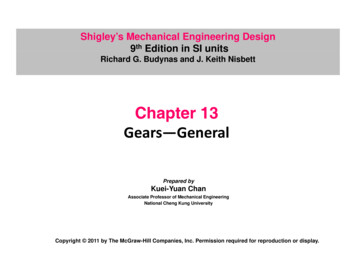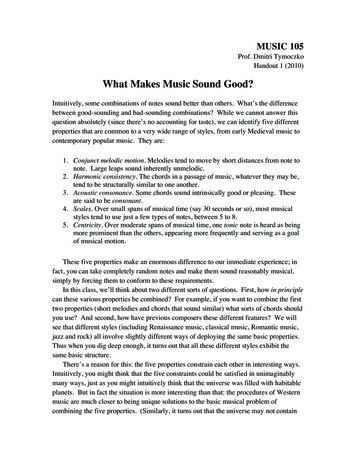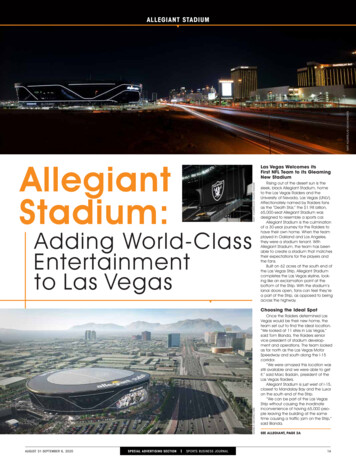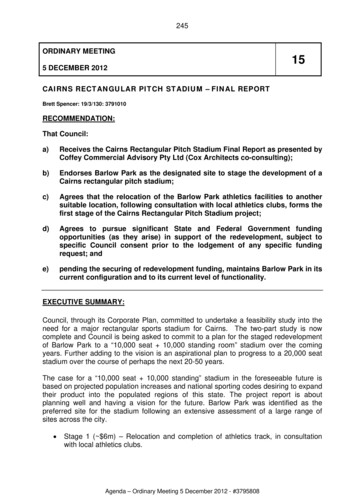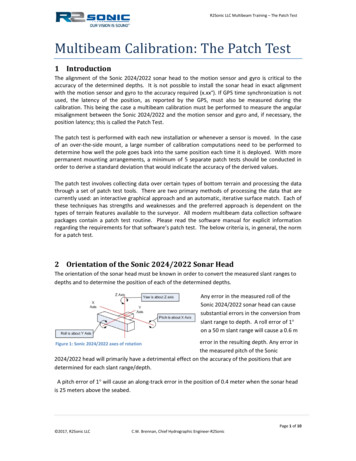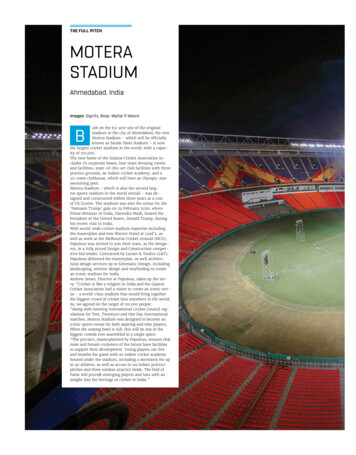
Transcription
THE FULL PITCHMOTERASTADIUMAhmedabad, IndiaImages: Signify, Bose, Walter P Mooreuilt on the 63-acre site of the originalstadium in the city of Ahmedabad, the newMotera Stadium – which will be officiallyknown as Sardar Patel Stadium – is nowthe largest cricket stadium in the world, with a capacity of 110,000.The new home of the Gujarat Cricket Association includes 76 corporate boxes, four team dressing roomsand facilities, state-of-the-art club facilities with threepractice grounds, an indoor cricket academy, and a55-room clubhouse, which will have an Olympic-sizeswimming pool.Motera Stadium - which is also the second largest sports stadium in the world overall - was designed and constructed within three years at a costof US 100m. The stadium was also the venue for the‘Namaste Trump’ gala on 24 February 2020, wherePrime Minister of India, Narendra Modi, hosted thePresident of the United States, Donald Trump, duringhis recent visit to India.With world-wide cricket stadium expertise includingthe masterplan and new Warner Stand at Lord’s, aswell as work at the Melbourne Cricket Ground (MCG),Populous was invited to join their team, as the designers, in a fully priced Design and Construction competitive bid tender. Contracted by Larsen & Toubro (L&T),Populous delivered the masterplan, as well architectural design services up to Schematic Design, includinglandscaping, interior design and wayfinding to createan iconic stadium for India.Andrew James, Director at Populous, takes up the story: “Cricket is like a religion in India and the GujaratCricket Association had a vision to create an iconic venue – a world-class stadium that would bring togetherthe biggest crowd of cricket fans anywhere in the world.So, we agreed on the target of 110,000 people.“Along with meeting International Cricket Council regulations for Test, Twenty20 and One Day Internationalmatches, Motera Stadium was designed to become aniconic sports venue for both aspiring and elite players.When the seating bowl is full, this will be one of thebiggest crowds ever assembled in a single space.“The precinct, masterplanned by Populous, ensures thatmale and female cricketers of the future have facilitiesto support their development. Young players can liveand breathe the game with an indoor cricket academyhoused under the stadium, including a dormitory for upto 40 athletes, as well as access to six indoor practicepitches and three outdoor practice fields. The Hall ofFame will provide emerging players and fans with aninsight into the heritage of cricket in India.”B
Populous’ masterplan also included four team dressingrooms and facilities, state-of-the-art club facilities and aVIP pavilion, an Olympic-size swimming pool, 76 corporateboxes and a media lounge with press rooms.With such a vast project, the task was huge for everyoneinvolved with the stadium – and there was plenty that Populous had to consider when it came to the design.“A great sporting venue is not only fit for purpose. Firstand foremost, it must be a great place to come together – avenue that creates memorable and extraordinary experiences for the fans and players. It also needs to be authentic and true to its location. For a nation like India, wherecricket is almost a religion, what could be better than beingpart of the biggest group of cricket fans in the world?”posed Andrew.“Operational flexibility is critical for the long-term viabilityof a stadium like Motera. The design of two open-seatingbowls with 360º views allows the operators to fill only thelower bowl for smaller matches and still create an excitingatmosphere for the fans. Four team changing rooms meansthe venue can host double-headers or cater for youth orcommunity tournaments.”With the sheer size of Motera Stadium, Populous had totake the fan experience into serious consideration. It wasvital that each visitor felt part of the action – somethingthat can be so easily lost in stadiums with a huge capacity.However, Populous had a plan to combat that, as Andrewrevealed: “For major cricket matches, the arrival on themain podium outside will be an experience in itself, as110,000 people make their way into the stadium.“As you enter the seating bowl, you will have your firstview of the whole arena from the concourse, so no matterwhere you move around the stadium, you stay connected tothe action. Every seat has uninterrupted sightlines and 360ºviews of the field and pitch. When you combine this with around, open bowl design, you get an amazing sense of be-040WWW.MONDOSTADIA.COMing together and you feel you’re a part of what’s happeningout in the middle.“Unlike many other stadiums of this size, the majority ofseats are general admission, ensuring the widest possiblegroup of fans can enjoy the action.”Although the project was clearly a successful one, it wasn’twithout its challenges, with the scale of the stadium presenting issues for the team involved.Andrew added: “The site was barely large enough to fit thewidth of the stadium and we needed to preserve an existingtemple. The solution was to develop a stadium consisting oftwo large seating tiers, each of approximately 50,000 seats,along with an additional 10,000 seats for VIPs and corporate patrons.“The timeframe was also relatively short – the stadium wasdesigned and constructed within three years.”The roof structure at Motera Stadium was a particularlycomplex part of the project, with Walter P Moore servingas roof structural engineer. The city of Ahmedabad, whereMotera Stadium is located, is in a level three seismic zone,meaning that the roof needed to be lightweight to reduceseismic demand and develop an economical roof system.Viral Patel, Director of Design at Walter P Moore, explainedfurther: “Seismic forces are proportional to the mass ofthe structure. Therefore, very early in the design phase, itwas decided that the best option would be to incorporate alightweight, cable-supported tensile membrane roof. Additionally, we decided that the reinforced concrete bowl andthe roof structure needed to be independent of each other.This decision was motivated by the seismic hazard for theproject.“Achieving a good performance of structure economicallyunder seismic events was the primary reason for separatingthe roof from the bowl. The bowl is a reinforced concretestructure that is inherently very heavy. The roof of MoteraStadium is a lightweight structure made up of tensile mem-
THE FULL PITCHbrane, cables and a steel perimeter frame. If the bowl androof structures were not separate from each other, it wouldhave created a very high seismic demand on the roof.“The prescriptive code requirements also allow inelasticbehaviour in a reinforced concrete structure when enhancedseismic detaining is adopted. The lightweight roof structure, on the other hand, is not arranged to readily accommodate inelastic behaviour. Without separating the bowlfrom the roof, the bowl would have been subjected to anamplified seismic demand from the roof.”Walter P Moore also used Load Response Correlation Method to develop critical wind load patterns from the windtunnel test.“Wind load provisions in most codes do not address roofstructure for stadiums such as Motera. Additionally, for astructure such as the Motera Stadium roof, it is very important to study the effects of unbalanced wind loads, which isnot covered in building codes. Accordingly, we decided tocommission a wind tunnel test to ascertain wind loads onthe roof accurately.”The Walter P Moore team faced challenges during the project, too, which Viral highlighted to MONDO STADIA: “Theroof erection involved synchronous pulling roof cables fromthe compression ring supported on ‘V’ columns. In orderto maintain proper cable forces during the entire erectionprocess, it was very important to avoid unbalanced loadingon the compression ring.“This process was challenging due to a limited number ofstrand jacks that were used during erection. However, various parties including L&T, Walter P Moore, and a specialtycontractor for cables came together and worked collaboratively, which resulted in a successful erection process.”Viral concluded: “Through Walter P Moore, I have workedon a number of sports projects. I grew up in the City of Ahmedabad before moving to the United States over 35 yearsago. Designing the roof for the world-class Motera CricketStadium was very special for me.”When Motera Stadium officially re-opens for international cricket matches, spectators will be treated to a pristine sound experience, courtesy of Bose Professional. Thecolossal venue boasts an immersive soundscape, due to thenew audio system, comprising a total of 162 units of theArenaMatch series. The system was acquired primarily toefficiently and effectively meet the increased aural demands. It has created a record of sorts for Bose Professionalas a brand in India – as it stands, it is the largest comprehensive sound system deployment from Bose Professionalin a permanent installation in the country.Vibhor Khanna, Country Manager – India & SAARC, BoseProfessional, commented: “We are extremely happy withthe sound system installation at Motera Stadium, and weare proud and honoured to have deployed this system inlight of the historical significance of the venue. This is thelargest cricket stadium in the world, and I consider thisinstallation as one of the feathers in the Bose cap. Thisis an amazing opportunity to showcase our latest ArenaMatch loudspeakers from the DeltaQ family of arrays andthe whole company is energised by this contract, which isamong one of our largest permanent installations in Indiato date.”The ArenaMatch system from Bose Professional was chosenas the preferred system for the venue after an on-sitesimultaneous live demonstration was conducted, featuringthree of the most reputed loudspeaker OEMs available inthe country.“The Bose Professional ArenaMatch line of loudspeakerswas launched during ISE in 2019 to coincide with the unveiling of the ArenaMatch installation at Philips Stadium inThe Netherlands, which provided consultants, Sis, and endusers an opportunity to witness the system’s sound quality,consistency, vocal clarity and flexibility in outdoor venuessuch as sports stadiums, arenas and outdoor entertainment041
THE FULL PITCHcentres,” Vibhor added.“After our return from ISE, we approached the GujaratCricket Association and L&T, and it was suggested to havean on-site shootout between three of the industry’s mostreputed PA brands. After evaluating the performance onvarious parameters, the authorities hailed Bose’s ArenaMatch system as the clear winner, and this is how webagged this prestigious project. Our systems are perfectlysuited to the demands of this world-class sporting arena.”Since the ArenaMatch system had just recently debuted atthe time, the brand had to make special arrangements toensure that the demo was executed perfectly as planned.Navin Datta, Sales Engineering Head - Bose Corporation,furthered: “At the time of the shootout, the company hadjust recently launched the product, so it wasn’t even available for demo. We had to request the head office to supportus with the demo units, which were then air-shipped toIndia just in time for the shootout. The outcome of thatpromptly arranged but wonderful demo almost closed thedeal for us.”Intimately involved in the planning of the sound systemdeployment, Bose Professional was instrumental in guidingthe GCA in setting up a world-class audio system. “Thedesign of the sound system had some inherent challengesof meeting the very high SPL levels required for stadium application, while also ensuring acceptable STI levels,especially given the high ambient noise levels of such largearenas,” said Navin.The main challenges in commissioning the system involveddelivering uniform and clear sound experience to everyseat, while maintaining average SPL levels of 100dBA plus,and assuring an STI of 0.5 or above, from already definedloudspeaker mounting locations.To achieve this, various models of the Bose ArenaMatchwere deployed throughout the facility - with the three sections in the venue; the Lower Bowl, the Upper Bowl and VIP042WWW.MONDOSTADIA.COMarea featuring multiple units of the AM10, AM20 and AM40boxes in meticulously planned specific configurations.While the Lower Bowl area features 16 arrays of four unitseach of the AM10, AM20 and AM40; the Upper Bowl areahas a total of 19 such arrays. Bose Professional productsare also used in three of the VVIP sections, as well as thebanquet area within the VIP section.With the Panaray 402 featuring a full-range-driver arrayand being fully outdoor rated, a total of 11 units have beeninstalled in the VIP section and 10 units in the VVIP section,eliminating the need for tweeters and crossovers, to provideunsurpassed reliability and vocal clarity. Furthermore, 10units of the Panaray 402 and six units of AM40 have beendeployed as point source to cover the banquet area withinthe VIP section.The Articulated Array design, with wide 120º x 60º coverage, reduces the number of required loudspeakers, whilethe 73Hz low frequency range reduces the need for subwoofers, providing a cost-effective solution.“The system, as a cohesive unit, delivers clearly audiblecommentary and voice announcements to every seat in thevenue,” Navin added.“We used a Bose EX-1280 C processor, which is aDante-enabled (64X64) DSP. It has on-board logic/controlto interface with third-party devices, and the same is usedto interface with fire evacuation systems of the BOH areas.Being Dante enabled, it can communicate seamlessly tovarious amplifiers installed across four control rooms.”The new Bose Professional system has certainly impressedsince its installation at Motera Stadium, as Vibhor concluded: “This design provides seamless coverage, volume andclarity for fans in all areas of the stadium. This major installation illustrates the depth and clarity of our high-performance loudspeaker systems and we look forward tofurther installations in similar venues in the future.”When it came to the lighting system at Motera Stadium,
THE FULL PITCHL&T commissioned Signify to provide the perfect solutionfor the venue.“We were involved in this project from a very early stageand worked closely with L&T to design and deliver thelighting to the ultimate end user - the Gujarat CricketAssociation,” said Sumit Padmakar Joshi, Market Leader forSignify’s Indian operations.“The lighting design was finalised after multiple iterationsto suit the need of the end user. The final design features aunique ring lighting solution on the canopy - a first for anystadium in India, which meets the customer’s requirementsof vertical illumination, uniformity ratios, glare calculations, shadow-free play and spill-over light.“The stadium also has the distinction of being India’sfirst LED floodlit cricket stadium that meets the International Cricket Council’s (ICC) broadcasting standards forsports illumination. The lighting system has been designedexclusively for sports and multipurpose venues, offeringoutstanding light quality, higher energy efficiency, effectivethermal management and a long lifetime.”Signify provided 580 Philips ArenaVision LED flood lightingluminaires for Motera Stadium, with the current installation being future ready, too.Sumit explained further: “The luminaires are arranged inthe form of a ring all around the stadium canopy, leavingthe forbidden zone as per the International Cricket Council’s broadcasting standards for sports illumination. As theluminaires are arranged all around the stadium, it ensuresexcellent vertical illumination for different camera positions located in the stadium. This lighting design, which iscurrently deployed in leading sports stadiums globally, alsominimises the effect of shadows during play.“The lighting illumination levels are configured to threeswitching modes to suit three different playing conditions- international, national and practice games. These switchmodes are controlled through a relay controller and thecontrol command can be sent through a computer and keypad setup located in the Field of Play (FOP) control room.”Motera Stadium is the first sports venue in India that features the unique ring lighting arrangement of LED luminaires installed on the catwalk of the stadium. This meantthat the Signify team had to do a mock-up installation ofthe lighting at ground level to ensure the actual installationwould be a success.“The Philips ArenaVision LED luminaries had to be installedat a height of 43-metres all around the catwalk of thisstadium. This presented a unique challenge of lifting allthe material at that height, which was done with the helpof construction cranes and pulleys. Installing equipmentat such a height also required a certified skilled workforcealong with the use of special PPE,” added Sumit.“The project material was supplied within three months onsite and the installation, testing and commissioning of thelighting system was completed in just three months - muchfaster than usual for projects of this scale.”Everyone involved in the Motera Stadium project has delivered a venue that Gujarat – and India as a whole – can beproud of. With expert design and state-of-the-art technology in place, it is surely ready to become a truly iconicvenue – and one of the world’s greatest cricket stadiums.CONTRACTOR: Larsen & Toubro ARCHITECT: Populous STRUCTURAL ENGINEER: Walter P Moore BRANDS: Bose Professional, Signify WEBSITES: www.larsentoubro.com,www.populous.com, www.walterpmoore.com, www.pro.bose.com, www.signify.com044WWW.MONDOSTADIA.COM
seismic demand and develop an economical roof system. Viral Patel, Director of Design at Walter P Moore, explained further: “Seismic forces are proportional to the mass of the structure. Therefore, very early in the design phase, it was decided that the best option would be to incorporate



